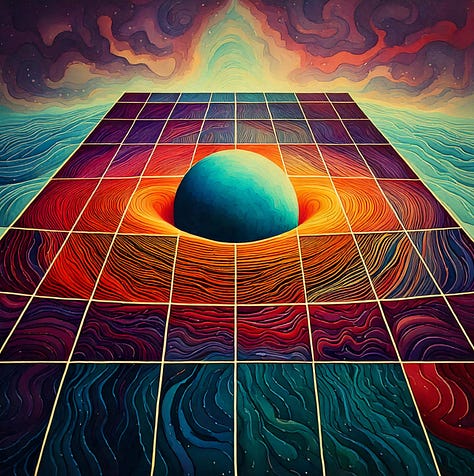Trust the process
Part 2: Gravitational waves and the art of imperfect visualization
It’s a crisp winter day and 20 advanced graphic design students are sitting in a design studio, Adobe Illustrator open, trying to visualize gravitational waves. Ripples in space-time that most of us can barely wrap our heads around.
Our initial attempts were experimental. Some designs looked like rippling pond surfaces. Others resembled quantum fever dreams. We were throwing visual spaghetti at the wall, seeing what might stick. Bringing our ideas into Adobe Firefly allowed for additional exploration and speculation.
That’s when Dr. Nico Yunes from ICASU joined us. He became our cosmic tour guide, offering critique and clarity as we worked through our designs. Some visualizations completely missed the mark. Others came surprisingly close to capturing something meaningful. What struck me most was how our human interpretations often conveyed truths the AI-assisted images couldn’t quite capture.









But the real magic happened in the misunderstandings. When a design fell short, Dr. Yunes explained why. Each moment of failure opened up a deeper conversation—not just about gravitational waves, but about the iterative process itself. Designers and scientists have more in common than you’d think: both rely on iteration, and every misstep brought us closer to understanding.
We left with some important takeaways.
First, visualizing massive concepts is inherently challenging. These ideas exist on scales far beyond human comprehension, so any attempt to distill them into a 2D design will always have limitations.
Second, static images can only go so far. Dynamic design and visualization—embracing movement and interaction—can help convey these complex ideas more effectively.
Third, collaboration is key. Impactful work can happen when we combine the expertise of scientists with the creative skills of designers.
And lastly, iteration is universal. Scientists and designers alike refine and revise constantly. Failure isn’t a roadblock.
Two moments from the day stick with me. In an earlier class, a student said they were going to trust the process. It sounds simple, but in practice, it’s hard. It’s so easy to feel lost or stuck when executing an idea. But trusting the process means leaning into the uncertainty, knowing that progress often comes from the messiest parts (just ask any designer to see their artboards…)
Later, as he was leaving, Dr. Yunes offered his own insight: Don’t be afraid to fail. It was a powerful reminder, especially for a room full of students engaging with such complex, intimidating ideas. Many of them felt uneasy, but they leaned into the discomfort—and that’s such an invaluable mindset for a designer. Growth comes not from avoiding challenges but from embracing them, even when the path forward isn’t clear.
Right now, our course might feel a bit unconventional. Designers learning about black holes? Experimenting with cosmic data? But there’s a purpose behind it all. We’re learning how to work across disciplines, push creative boundaries, and present work with clarity and intention. This isn’t just about creating—it’s about collaborating, iterating, and trusting the process to lead us to something meaningful.
This is the second in a series documenting our experimental work in Typographic Systems. Follow along as we continue to explore the intersections of design, science, and artificial intelligence.



